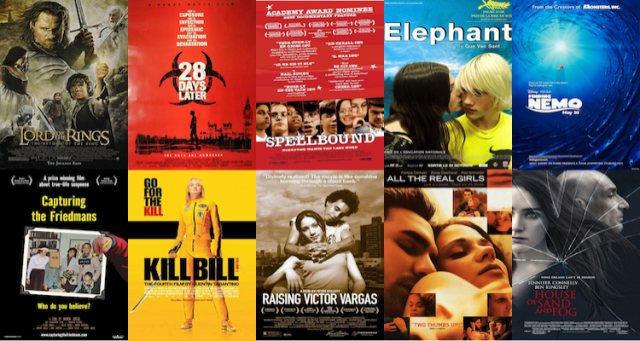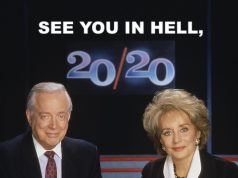
2003 was dominated by “Lord of the Rings,” with “The Two Towers” occupying everyone’s attention at the beginning, anticipation for “Return of the King” keeping us alive through the middle, and the actual viewing of “Return of the King” giving the year a glorious conclusion.
Mixed with all that, we find it was a year of great documentaries, of many, many horror films, and a few too many comic book movies. Actors continued to surprise us (Bill Murray in “Lost in Translation”), and directors continued to turn genres upside-down (Quentin Tarantino’s “Kill Bill, Vol. 1”).
It was a great year for Sundance again, too: Four of the films on this list (Nos. 2, 6, 8 and 9) made their American debuts there.
It is interesting to note how often young people turn up in the best films of the year. There are nerdy ones (“Spellbound”), troubled ones (“Elephant”), lost ones (“Finding Nemo”), and devastated ones (“Capturing the Friedmans”), plus some very normal ones (“Raising Victor Vargas,” “All the Real Girls”). That’s not to mention the memorable supporting roles by children in films that did not center on them: Vivica A. Fox’s young daughter coming home from school in “Kill Bill” is one of that film’s most alarming sequences, and Ben Kingsley’s son in “House of Sand and Fog” brings the plot to a boil there.
Why so many good movies about young people? Young people’s innocence makes for charming entertainment; their loss of innocence creates urgent drama. We like the way children think, the way they see the world. They have not yet been spoiled by the harsh facts that comprise a grownup’s reality.
“The Lord of the Rings” is not about children, except that it is. The Hobbits are short, guileless, happy folks who spend carefree days in what seems to be an endless summer. When that existence is threatened, they — and we — see how imperative it is that the threat be eliminated so that they can return to their idyllic lives in the Shire. I think we all want, at least subconsciously, to return to our childhoods, to our Shires. We recall with fondness the untainted worldview we held then, and wish we had not learned so many things that changed it. Films like “Lord of the Rings,” and others that celebrate the attributes of youth, give us hope that child-like optimism is possible even in adulthood.
1. “The Lord of the Rings: The Return of the King” It’s hard to separate one’s feelings for the final chapter of this masterful trilogy from one’s feelings for the series as a whole. I’ve given up trying. Viewed as one 9-hour film, “The Lord of the Rings” is an astonishing achievement, and one whose influence will be felt for decades. Seldom have we been blown away by technology while feeling for the characters, too; it’s usually one or the other. Peter Jackson and company reminded us we can have both. I hope the success of these films will inspire other filmmakers to strive for perfection not just in special effects, but in human effects.
2. “28 Days Later” In a year jam-packed with horror films, this British import stood out as a singularly frightening and vivid one, focusing more on the psychology of its characters than on their dismemberment. So few purveyors of this genre have ever gotten it right that it’s almost startling to see it happen: If we care about the characters — if we like them — heck, if we even know their names — we’re far more likely to be scared for them. It’s a film about people, not about zombies, but the zombie parts are thrillingly executed, too, making the film a truly entertaining scare.
3. “Spellbound” Yeah, the title’s a pun, but I’ll overlook that offense because “Spellbound” is exactly what audiences are when they watch this documentary about the 1999 National Spelling Bee. Following a handful of contestants before and during the competition, we choose favorites, predict winners, and hold our breath as they go for the G-O-L-D. Because it’s real life, anything can happen: There’s no “main character” whose destiny is obviously to win. Who would have thought spelling bees could be so suspenseful, or their contestants so warm and funny?
4. “Elephant” This mesmerizing fictionalization of the Columbine shootings is eerily calm, so low-key that a reading of the screenplay would probably convince you it was a boring film. It’s the way it’s filmed — like a fly on the wall, following students through an ordinary day leading up to the massacre — that draws you in. The senselessness of violence never seemed so tragic.
5. “Finding Nemo” Pixar’s winning streak continues with this beautiful, fanciful, funny story about parenthood and family. Pixar is a national treasure.
6. “Capturing the Friedmans” Documentaries are often only as interesting as their subject matter, but this one takes it further. The harrowing case of a New York family torn apart by allegations of child molestation is made all the more compelling by director Andrew Jarecki’s method of storytelling, which reveals the facts slowly and carefully to maximize our interest. When it’s over, we’re still not sure who’s right and who’s wrong, but we’ve seen documentary filmmaking at its most intriguing.
7. “Kill Bill Vol. 1” Having praised “Elephant” for showing the senselessness of violence, I feel obligated now to defend my inclusion on this list of “Kill Bill,” a film that wallows in violence and uses it — rather effectively, I might add — as entertainment for its audience. Some have argued that if it weren’t for films like “Kill Bill,” we wouldn’t have tragedies like those in “Elephant,” though that’s a pretty serious oversimplification. The point is, different films serve different purposes. Quentin Tarantino’s homage to ’70s martial arts films and to violent cinema in general is explosively entertaining and artfully composed. Most of the blood is, in fact, so over the top that it becomes an intentional parody of the genre.
8. “Raising Victor Vargas” This affectionate look at love and romance among inner-city youths is so full of natural, unaffected humor that you’d think you were watching the people next door (assuming you live in a Dominican neighborhood of New York). The performances are as life-like as anything I saw all year.
9. “All the Real Girls” Ditto the performances in this film, which examines love and romance among small-town youths. Interesting to note how, in Manhattan or rural North Carolina, love is the same, and people in love act the same. What a beautiful film this is.
10. “House of Sand and Fog” Though I think it gets a bit plotty in the end, that doesn’t diminish the strength and majesty of this quiet, powerful film in which a house means everything in the world to two different people. Ben Kingsley’s performance is amazing.
NOTE: “The Triplets of Belleville” was a 2003 release that, unfortunately, I was not able to see until January 2004. Had I seen it in time, it would have placed No. 4 on my list, and pushed everything else down (with No. 10 falling off the list altogether; sorry, Mr. Kingsley).
Honorable mentions: “Big Fish,” “Elf,” “School of Rock,” “Better Luck Tomorrow,” “Mystic River,” “The Last Samurai,” “The Station Agent,” “Winged Migration,” “The Secret Lives of Dentists,” “Freaky Friday,” “Seabiscuit,” “Lost in Translation,” “Shattered Glass.”
AND THE WORST…
You can’t have a best list without a worst list; it would upset the balance of the universe. To determine the worst films of the year, I first consulted my database to see which movies had received F or D- grades from me. To determine which order they should appear in, I reflected on which films still, at the end of the year, left a bad taste in my mouth.
1. “Bad Boys II” I gave this film a D-, suggesting there was something in it that saved it from being an utter failure. Looking back, I cannot imagine what that thing was. This is bloated, offensive, loud, bombastic, irritating filmmaking at its absolute worst.
2. “Day of Defense” At last, the sub-genre of Mormon cinema has found representation on the year-end lists! Sadly, it is on this end of the list. While “Bad Boys II” was more irritating, “Day of Defense” was by all technical measures a worse film, with worse acting, worse direction, worse editing, and so forth. Nothing in the film is plausible; much of it is inadvertently laughable. Luckily, no one saw it: It exited theaters six days after it was released.
3. “House of 1000 Corpses” A hateful, vicious piece of work by a guy from a band called White Zombie. After three years of behind-the-scenes struggles, the film finally made it to theaters, but whoops! It turns out to have been a pile of crap.
4. “From Justin to Kelly” Even I, as a fan of “American Idol,” knew this was a bad idea from the get-go. How come I’m smarter than the people who made it?
5. “View from the Top” Gwyneth Paltrow walks daintily onto the movie screen, drops her drawers, and defecates on the audience. Mike Myers makes a cameo.
6. “Grind” It’s a movie about skateboarding. Let me reiterate: It’s a MOVIE, but it’s about SKATEBOARDING. It’s a full, feature-length, charge-you-nine-dollars-to-see-it MOVIE … and yet, it’s about SKATEBOARDING. (P.S. It’s also a BAD movie about skateboarding.)
7. “Masked & Anonymous” Not many truly awful films come out of the Sundance Film Festival, but when they do suck, they suck with a vengeance! This Bob Dylan vanity project (didn’t know he had any vanity, did you?) is so incomprehensible, only Bob Dylan can understand it. And of course he can’t explain it, what with the speech impediment and all.
8. “The Cat in the Hat” It’s unfair to criticize a movie for being different from the book its based on, because all that matters is whether it works as a film. So here’s the thing: Putting aside the fact that “The Cat in the Hat” destroys everything the book represents, it’s STILL a terrible movie, full of obnoxious behavior and unfunny slapstick. Mike Myers had a cameo in “View from the Top,” too, making him the least-appealing actor of the year, except for …
9. “National Security” … Martin Lawrence who didn’t just have cameos but STARRED in “National Security” and “Bad Boys II.” Even the presence of Steve Zahn, who is usually funny, failed to make this loud dreck tolerable, primarily because Martin Lawrence is so unfunny, he sucks the funny out of everything around him. True story: “National Security” was playing at the multiplex right next to “Blazing Saddles,” and it acted as a humor vacuum so that “Blazing Saddles” became a tragedy. People came out of it sobbing.
10. “Boat Trip” Consider this Cuba Gooding Jr.’s award for all-around bad acting, having appeared in this debacle as well as “Radio” and “The Fighting Temptations.” Next year, he will be appearing in your local Arby’s as a night manager.
Dishonorable mentions: “Darkness Falls” (darkness sucks!), “Biker Boyz” (it’s a MOVIE about MOTORCYCLES), “Gigli” (pronounced “jiggly,” like J-Lo), “Mona Lisa Smile”
MISCELLANEOUS NOTES
Longest film of the year: “Gods and Generals,” 220 minutes.
Shortest film of the year: “The Jungle Book 2,” 72 minutes.
Most enjoyable bad movie: “Timeline”
Least enjoyable good movie: “Irreversible”
Best performance in a bad movie: Adam Brody in “Grind”
Worst performance in a good movie: Kevin Costner in “Open Range”
Least surprising surprise: The “twist” at the end of “The Life of David Gale”
Craziest surprise: That “Pirates of the Caribbean,” based on a theme park ride, was actually really good
Funniest death: Tie between Wheezy Joe in “Intolerable Cruelty” and the little girl in “Day of Defense”
Proof that God exists: Freddie Prinze Jr. did not make a movie this year, but Quentin Tarantino did.




